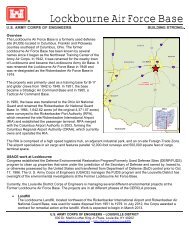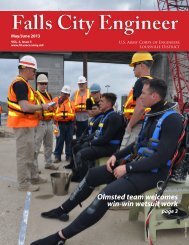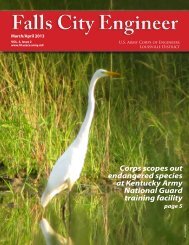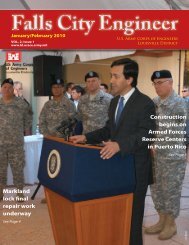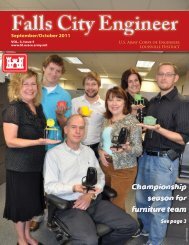July/August - Louisville District - U.S. Army
July/August - Louisville District - U.S. Army
July/August - Louisville District - U.S. Army
- No tags were found...
You also want an ePaper? Increase the reach of your titles
YUMPU automatically turns print PDFs into web optimized ePapers that Google loves.
Continued from page 3dredging due to the extremely low water.This spring he and Olmsted project managerMatt Lowe traveled to Frankfort fora face-to-face to allay KDW’s concernsabout the potential environmental impactof more open-water disposal.“The presentation quickly illuminatedthe time-event progression of large sandwaves working past Olmsted whichprevented the area from being a stableenvironment for mussels and fish,” Vesselsexplained. Vessels was also able toaddress KDW’s apprehension about thefish spawning season April 15-June 15 bypointing out that the area for open-waterspawning between Cairo and Smithland,Ill., covered more than 20,000 acres andthe dredging and pile driving would impactless than 10 acres.Bradley said the Hurley performedpretty much as expected. In addition toremoving the sand wave, it dredged a largesilt trench that he said is helping reducesediment infill on the foundation footprint.“The Hurley’s work around the pileheads on the tainter-gate footprint for SillShell 5 was experimental for us,” Bradleysaid. “We did not get all the material removedfrom around the pile heads that wewould have liked, but a large amount wasremoved and dive time on the footprintshould be significantly reduced.”He estimated the Hurley has the potentialto put the project schedule ahead byabout six weeks on an annual basis whennormal seasonal low-water conditionsreturn.Environmental<strong>Louisville</strong> engineers survey desert terrain at Fort BlissThe <strong>Louisville</strong> <strong>District</strong> partnered with the USACE Huntsville Center to conduct a survey of the Castner Range at Fort Bliss, Texas.Katie Newton, public affairsup and walked the grid pathways,” said sion makers on if additional investigationsU.S. <strong>Army</strong> Corps of Engineers Steele. “Each team had a hand-held device are warranted and if a risk to users of the(USACE) <strong>Louisville</strong> <strong>District</strong> staff with a GPS locator on it that we could followsite exists,” said Coombs.members Craig Coombs, environmentalscientist and Aaron Steele, environmentalengineer recently partnered with theUSACE Huntsville Center (HNC) toconduct a survey of the Castner Range atFort Bliss, Texas.The pair joined four other USACEexperts — two from Huntsville <strong>District</strong>and two from Fort Worth <strong>District</strong> — toconduct the 2,500-acre survey June 10-12.The survey, a search for anomalies orMunitions of Explosive Concern (MEC),consisted of visual and electromagneticcomponents with a metal detector.A digital grid was laid out over theproperty boundary on 50-foot intervals tosurvey the acreage. “The two teams, eachwith one person from <strong>Louisville</strong>, one fromFt. Worth, and one from Huntsville splitto the next point on the grid.”As the teams would navigate from onegrid point to the next they would performa visual inspection and sweep with themetal detector. “At 100-foot intervals wewould record, on the GPS device, anyanomalies that were found,” said Steele.“This data was geo-referenced and recordedinto an ArcGIS database in real time aswe were entering the data we collected.”The next step to completing the surveyis to finish surveying a small portion ofextremely rugged terrain that wasn’t ableto be surveyed due to access restrictions.Coombs and Steele have offered theirservices to help complete the un-surveyedportions at a later date.“The ultimate goal of the survey willbe to make a recommendation to the deci-Additionally, this survey also served asa great training opportunity for the <strong>Louisville</strong><strong>District</strong> staff members. “Our environmentalengineering branch doesn’t havethe same area of expertise in the MilitaryMunitions Response Program (MMRP)realm that they do,” said Steele. “IdentifyingMEC and running the electromagneticdevice is something that we still have tobecome familiar with.“More partnering like this surveyand additional training would be a pathtowards becoming more valuable to theHuntsville Center,” said Steele.Aaron SteeleBUILDING STRONG® Volume 5, Issue 4 4
Civil WorksHarmful algal blooms cause concern at Corps lakesTodd Hornback, public affairsThe U. S. <strong>Army</strong> Corps of Engineersis cautioning boaters and swimmersat several district lakes about possiblecontact with blooms of blue-greenalgae capable of producing toxins that canbe especially harmful to small children,those with illness and animals.Although a natural occurring phenomenonin lakes and streams, higher counts ofthe harmful algal blooms have been foundat <strong>Louisville</strong> <strong>District</strong> Brookville, C.M.Harden, Mississinewa, Patoka, Roush, andSalamonie reservoirs in Indiana; BarrenRiver, Nolin River, Rough River and Taylorsvillereservoirs in Kentucky; and C.J.Brown and Harsha reservoirs in Ohio. TheCorps is monitoring other district lakes tosee if there are additional blooms at otherreservoirs.“We want to keep the public informedof the harmful algal blooms and let everyoneknow of simple precautions lakevisitors can take while still enjoying ourrecreational opportunities,” said DianeStratton, Rough River Lake Corps parkmanager, one district Corps lake with algalblooms above the 100,000 cell count.The lakes remain open to recreationalusers for swimming and boating but visitorsshould be aware of the possibility ofadverse health impacts associated withcontact with the water.Precautionary measures include:• Avoiding contact with visible algaeand not swallowing water whileswimming.• Taking a bath or shower with warm,soapy water after coming in contactwith water in ponds and lakes, especiallybefore preparing or consumingfood.• Removing fish skin and organs beforecooking; do not consume or allowanimals to consume the organs orskin.• Washing clothing, rinsing lifejacketsand equipment with fresh water afteruse.Animals should not be allowed to swimin or drink untreated water from thesesources. Animals can be poisoned by thetoxins produced by some algal blooms.Small animals can ingest a toxic dosequickly.Dogs are particularly susceptible toblue-green algae poisoning because thescum can attach to their coats and be swal-Harmful algal blooms at J. Edward Roush lake in Huntington, Ind., this summer.lowed during self-cleaning.According to World Health Organizationguidelines, the algal cell counts are atthe cautionary level, and present a higherrisk of causing health concerns for allpeople and animals that come in contactwith the water. Clinical signs of bluegreen algae poisoning in animals includevomiting, diarrhea, decreased appetite,weakness, seizures and in extreme levelsof toxins, sudden death, especially inlivestock.The Corps of Engineers is workingwith state agencies in Indiana, Kentuckyand Ohio to:• Continue water quality monitoringand provide results to the public• Monitor any potential blooms on siteat the lake• Post advisories at the lake in conspicuousplaces – either “advisory”(potential health affects) or “caution”(more significant risk of healthimpacts of HAB)• Keep boaters, swimmers and thosewho recreate at the lake informed ofthe possible risks“Harmful algal blooms are not typicalalgal blooms,” said Clark Dorman,manager of the Water Quality Branch,Kentucky Division of Water. “HABs area form of cyanobacteria, or blue-greenalgae, that may produce toxins that cancause nose and skin irritation and otherillnesses in humans and animals....As thesummer progresses, we will continue totrack these levels and advise the publicappropriately.”Barren River, Nolin River and RoughRiver lakes provide water to local water/utility companies. The utility companieshave been notified of the algal blooms.For specific inquiries about drinking waterquality, contact the local utility office.Factors promoting algal growth includesunlight, warm weather, low turbulence,sewage and nutrient sources such asphosphorus and nitrogen. Phosphorous isparticularly important in fueling cyanobacteriagrowth in the harmful algal blooms.“The presence of harmful algal bloomsdoes not signify toxins are present, butdoes signify the possibility of toxins andpossible impacts to people and animals.It’s important that people are aware so thatthey can make an educated decision forthemselves and their families,” said JadeYoung, Corps biologist. “People need totake into account their individual healthconcerns before participating in water recreationalactivities. Harmful algal bloomlevels vary and can impact individualsdifferently.”For more informationVisit the <strong>Louisville</strong> <strong>District</strong> HAB pageIf you have questions, contact the U.S.<strong>Army</strong> Corps of Engineers lake offces:Barren River Lake: (270)646-2055Brookville Lake: (765)647-6701C.J. Brown Reservoir: (937)325-2411C.M. Harden Lake: (765)344-1570William H. Harsha: (513)797-6081Mississinewa Lake: (765)473-5946Nolin River Lake: (270)286-4511Patoka Lake: (812)678-3761Rough River Lake: (270)257-2061J. Edward Roush Lake: (260)356-8648Salamonie Lake: (260)782-2358Taylorsville Lake: (502)477-8882BUILDING STRONG® Volume 5, Issue 4 5D.J. Unger
Military ConstructionCorps completes Infantry Platoon Battle CourseKatie Newton, public affairsThe Corps recently completed asprawling 500-acre AutomatedInfantry Platoon Battle Course (IPBC) atFort Knox, Ky., where Soldiers can train.The project converted a previouslyused Tank and Bradley gunnery range,known as the Cedar Creek Range, into anew battle course, which will train and testinfantry platoons on the skills necessary toconduct tactical operations with direct andindirect live fire.“It’s a very important project becauseit not only supports all units training hereat Knox, but also units who travel here totrain so it’s very important for the <strong>Army</strong>overall,” said Rodney Manson, installationrange control officer, Fort Knox.The battle course features 43 stationaryinfantry targets, six stationary armortargets with battle effects simulator, onemoving armor target, nine machinegunobservationbunkers equipped with asound effects simulator, eight mortarsimulation devices, 14 moving infantrytargets, one trench obstacle, two helicopterlanding zones and one assault/defendhouse to ensure optimal training for theinfantry platoons.One important feature of the new battlecourse is video recording capability, whichprovides Soldiers with real-time feedbackand allows for after action reviews.Photo ContestFirst place: Haylee’s favorite thing to do is ride on the boat at NolinRiver Lake.The 500-acre Infantry Platoon Battle Course at Fort Knox features trenches, which the Soldiers willuse during training scenarios.“It’s one of the few ranges that has thatcapability,” said Manson.In addition to the battle course, therewere necessary site improvements thathad to be made including installation ofelectric service, information systems anddemolition of two buildings. Other facilitiesthat had to be constructed include therange operations center, the range operationsand control area, which consists ofan operations and storage building, class-Ashley Warrickroom building, covered mess, bleacherenclosure, aerated vault latrine, and ammunitionbreakdown building surroundinga central parking lot, and building informationsystems.The $4.2 million project was constructedby Barlovento LLC., Dothan,Ala., Construction was completed June8, and the new range will be in use by thefall after additional computer systems andtargets are installed.Every dog has her dayCongratulations to Ashley Warrick, winner of the 2013 <strong>Louisville</strong><strong>District</strong> visitor photo contest. Her photo of furry friend Haylee on a boatat Nolin River Lake made the judges say “Awwww.”Funds permitting, this photo will be featured in the 2014 <strong>Louisville</strong><strong>District</strong> calendar.In second place is Keith Branauer’s shot from an early morning fishingtrip, and Brian Churchill’s photo of an evening wakeboarder came inthird.The photos, as well as previous year’s winners can be viewed on the<strong>Louisville</strong> <strong>District</strong> Facebook page: http://www.facebook.com/<strong>Louisville</strong>USACE.The district thanks everyone who submitted photos. Keep safelyenjoying the lakes, and don’t forget your cameras!BUILDING STRONG® Volume 5, Issue 4 6Scott Hennig
<strong>Army</strong> ReserveCorps keeps busy with Reserve projectsCarol Labashosky, public affairsNewtown (Danbury), Conn.Belton, Mo.Michigan City, Ind.The Newton (Danbury) Conn., <strong>Army</strong> Reserve Center is approximately75 percent complete. “We will see significant progress overthe next couple of weeks,” said Greg Cardwell, project manager.The <strong>Army</strong> Reserve conducted a ribbon cutting ceremony in Junefor the completion of the new <strong>Army</strong> Reserve Center in Belton, Mo.David Reed, project manager said the completed project was appealingand an extremely functional facility due to the way each buildingwas located on the site. During the ribbon cutting ceremony varioustroop members expressed how excited and proud they were of thenew reserve center. The project began construction in December of2011.The Michigan City, Ind. <strong>Army</strong> Reserve Center construction isprojected to be complete in the fall of 2013. Tom Murphy, projectmanager, explained that the successful furniture installation is partof the “final punch report” which is how the Corps reviews and approvesa completed aspect of a project. “The facility is very attractive,and the designer, construction team, and the furniture suppliers/installers should be commended for a job well done,” said ShannaMiller, furniture project management specialist.Candace Cornette Milligan Frederick KraftRoger Frey, The Korte CompanyBUILDING STRONG® Volume 5, Issue 4 7
SafetyVolunteer first responders balance safety equationFirst responders in the equipment conex are (from left to right) casting yard manager Bob Wheeler,carpenter general foreman Bobby Miller, site EMT Melissa Crisman, ironworker superintendent GlenBragg and batch plant superintendent Rich Hamilton. The crash dummy is used for rescue drills thattrain removing an injured worker on a stretcher.Jon Fleshman, Olmsted DivisionMen overboard, severe abdominalcramps and a fall from a scaffoldare some of the real-life emergenciesOlmsted’s volunteer first responder teamhas assisted with since it stood up in 2010,according to casting yard manager andoriginal team member Bob Wheeler.The Olmsted Locks and Dam constructionproject is on the Ohio River betweenIllinois and Kentucky about 17 milesupstream from its confluence with theMississippi. Southern Illinois is an area ofvery small towns sparsely scattered acrosslightly populated expanses of soybean andcorn fields. The numbers of hospitals andhealth care providers reflect this fact.“We formed the first response teamafter one of our craft folk was injuredduring a concrete placement,” Wheelerexplains. “The emergency responders inthe surrounding counties were unpreparedfor a response to our site and since we’rein such a remote location the ambulancetook nearly an hour to arrive.”General superintendent Dave Phillipsassisted in getting the ball rolling.“I held a weekly meeting for the coregroup and we assigned responsibilities tomembers,” Phillips recalls. “As a team,we reviewed and completed our charter,set up and got approval to have a first-aidconex (a movable, metal container) and anon-site ambulance. We also planned andheld rescue drills and held a review meetingafter each one for lessons learned. Asa team we recruited others and held groupmeetings discussing the charter and definingthe responsibilities of each member.”The Corps of Engineers’ residentengineer notes that with a project of thissize and magnitude–with marine and castingyard activities–there’s a high level ofexposure to site personnel.“Having the first responders group onsite gives our workers a higher level ofprotection,” says Brad Bradley. “This isthe first job I’ve been on that has such adeveloped emergency-response capacityand I’ve been at very, very remote sites.”Wheeler says they started by finding afew volunteers with first-response experienceto help write procedure to follow incase of an incident. Then the few lookedfor others willing to participate and theteam was formed with six or seven members.As of June 2013, 55 volunteers fromlaborers to crafts to office staff comprisethe Olmsted first-response team – and thenumber is likely to increase during thelow-water season when the size of theworkforce peaks to handle shell-placingactivities.“There are not qualifications necessaryto be on the team other than the desireto help,” Wheeler says. “We train eachmember in first aid, CPR and use of adefibrillator. Not everyone is able to assistthe injured but many are able to help bydirecting traffic, escorting the ambulanceJon Fleshmanand crowd control.”The Washington Group-Alberici jointventure’s full-time emergency medicaltechnician says many of Olmsted’s firstresponders already have related trainingand experience.“The team includes firefighters orthose who were, some who do or didSAR (search and rescue) and some statelicensedfirst responders in their owncommunities,” explains Melissa Crisman,site EMT. In addition to the classroomtraining she organizes, Crisman says, thevolunteers participate in man-overboarddrills once a month and other drills twicea year that involve responding to a varietyof job-related scenarios.“Part of the training is a constantfamiliarization with their emergencyequipment,” Crisman says. The equipmentis stored in a conex trailer in the castingyard and it includes stretchers, Stokesand aerial retrieval baskets, specializedrigging, backboards, gloves, flashlightsand a first-aid kit. The equipment has beencompiled with the purpose of assisting theinjured until professionals arrive.“The minute ‘clear channel one’ happens(the channel used for emergencieson their two-way radios) and the incidentlocation is communicated, a forklift drivergoes to the conex and brings it to the incidentsite or as close as possible,” Crismansays. She also points out that a helicopterlanding zone has been prepared and settingup the ground guidance lights are part ofthe team’s training.The emergency response vehicle andthe crash dummy used for training wererustled up by the Corps of Engineers’resident government property administratorthrough GSAXcess. Dave Hawley saidthe cost to the project was transportationof the items to the site and minor maintenanceto ensure they are safe to operate.Douglas Callor, the full-time site safetyand health officer, says the combinationof the members’ emergency responsebackgrounds and their excellent reactiontimes to incidents are some of the team’sbiggest contributions to the project’ssafety program.“We’re remote and they can providealmost instant care to an individual,” saidCallor.BUILDING STRONG® Volume 5, Issue 4 8
SpotlightEngineers Without BordersCivil engineer puts skills to use in MoroccoKatie Newton, public affairsWith a passport and work boots intow, Brian Phelps, U.S. <strong>Army</strong>Corps of Engineers <strong>Louisville</strong> <strong>District</strong> civilengineer took a break from his desk joband flew to Morocco in June to volunteerwith Engineers Without Borders (EWB).EWB sends professionals and studentsto developing countries around the worldto construct necessary engineering projects.When a friend and former <strong>Louisville</strong><strong>District</strong> co-worker asked Phelps to serveas a professional mentor with a groupof students from Columbia University,Phelps couldn’t pass up the opportunity.While overseas, Phelps primarilyhelped oversee and assist with constructionof a 210-foot long footbridge in theAit Bayoud community. “Consistentaccess to many facilities and services inthe community such as schools, the healthclinic and markets was impossible duringthe rainy season due to severe flashflooding over the Tagawowt River,” saidPhelps.Students constructed the bridge alongwith local labor and two representativesfrom the Peace Corps. In addition tomentoring the students and troubleshootingproblems, Phelps was responsible forinstalling safety netting on both sides ofthe bridge.“Working with the students and helpingthe locals of Ait Bayoud has beenan amazing experience,” said Phelps.“Watching the residents cross the bridgefor the first time is something I’ll neverforget.”Phelps, who travelled to Moroccotwice this year—for ten days in Januaryand most recently in June—says the experiencehas enriched his life.“With EWB, I’ve been able to see adifferent part of the world that I more thanlikely never would have and have beenable to meet other engineering professionalsfor possible networking in the future,”said Phelps.Brian Phelps, civil engineer, U.S. <strong>Army</strong> Corps ofEngineers <strong>Louisville</strong> <strong>District</strong>, deployed to Moroccoas a mentor with Engineers without Bordersto help construct a footbridge so the Ait Bayoudcommunity could still access their schools andhealth clinics during the rainy season.Brian PhelpsBUILDING STRONG® Volume 5, Issue 4 9





